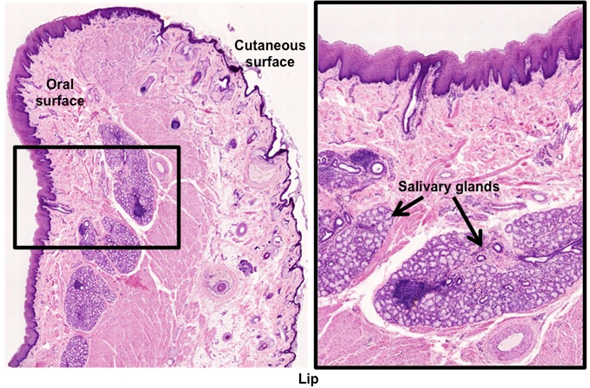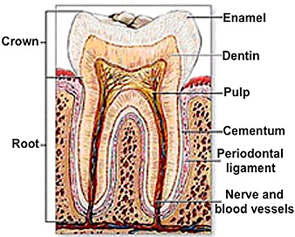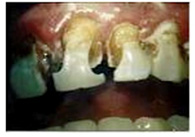|
The oral cavity contains
structures for ingestion and fragmentation of food, resulting in
formation of a bolus of food for swallowing. The lips, tongue, and
palate assist in bringing food into the oral cavity and positioning
it during chewing and swallowing. The tongue and lips also
participate in speech, and the tongue contains sensory receptors
(taste buds) that provide the sensation of taste. The salivary
glands secrete saliva containing mucus that moistens food and
enzymes that initiate digestion.
- Examine the images below and
these sections of lip (sample
1 and sample 2).
The skin on the external surface (containing typical features of
skin, e.g. hair follicles and sebaceous glands) merges into the
nonkeratinized, stratified squamous epithelium of the oral
mucosa on the internal surface. Note that the oral epithelium is
thicker. Locate the small salivary glands in the submucosa of
the lip and the skeletal muscle.

- Examine the diagram below and
this section of an adult
tooth, which is from a decalcified tooth still embedded in
the bone of the jaw. The enamel, a calcified material similar to
bone, is completely dissolved away. Identify the following
structures:

- Dental pulp
- Odontoblasts
- Predentine
- Dentine
- Bone
- Periodontal ligament
- Cementum
- Dentine
- Gingiva
- Examine this section of
developing
tooth
in the lower jaw of the fetal skull. Identify the dental pulp, odontoblasts, dentine, enamel (partially gone), and the
(partially disrupted) layer of ameloblasts.

Clinical note: The oral cavity
has a large and varied bacterial flora. Bacteria may accumulate and
form a layer (plaque) on a tooth, releasing acids that demineralize
the enamel and dentine and produce dental cavities. Other bacteria
proliferating in the gingival cleft may destroy the periodontal
ligament, cause resorption of alveolar bone, and loosening of teeth.
Next is the tongue. |